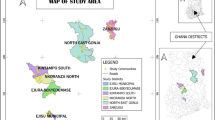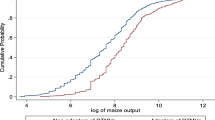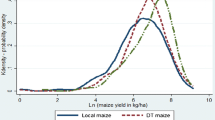Abstract
Climate change is a major problem undermining agricultural production in Africa. Consequently, efforts are being made to provide farmers with adaptation technologies, but little empirical research exists on the determinants of adopting such technologies. This article addresses this research gap, using the case of drought tolerant maize (DTM) technology in Nigeria. With survey data from 200 farm households and econometric techniques, we explore the determinants of whether to invest and how much to invest in adaptation technology by smallholder farmers. Results from the study indicate that among the key determinants of adoption are access to the technology, complementary inputs, extension services, and climate change information. We also show that off-farm income and wealth status of a household play a significant role in adoption, implying capital constraints; hence, it can be difficult for resource-poor farmers to adopt the technology. Moreover, the farmers identified cost of the technology and complementary inputs, particularly fertilizer as major constraints to adoption. We conclude that while the DTM technology is suitable and important in helping smallholder maize farmers to continue to produce under a changing climate, more support is needed for them to invest in the technology and overcome adoption constraints. Necessary interventions include improving access to information about climate change and the available adaptation technology, timely access to the technology and complementary inputs, and improving access to credit, particularly for the resource-poor farm households.

Similar content being viewed by others
Notes
Drought tolerance maize is a collective term for maize varieties that are drought tolerant and/or early maturing, hence able to escape drought.
Households were asked to indicate their ownership of 10 assets that could define ‘’wealth” in the study area. Following Filmer and Pritchett (2001), we used principal component analysis (PCA) to assign weights to each asset. The assigned weights were then used to construct household wealth index, using the formula:
$$ {w_{{j{ }}}} = {{{\sum\limits_{{i = 1}}^k {\left[ {{b_i}\left( {{a_{{ji}}} - {x_i}} \right)} \right]} }} \left/ {{{s_i}}} \right.} $$Where w is the wealth index for each household; b represents the weights (scores) assigned to the assets on the first principal component; a is the asset value for each household; x is the mean value of each asset; and s the standard deviation of the assets.
Mudu is a bowl used in measuring grain in the study area. A mudu is equivalent to 2.5 kg
References
Abdoulaye T, Sanogo D, Langyintuo A, Bamire S, Olanrewaju A (2009) Assessing the constraints affecting the production and deployment of maize seed in DTMA countries of West Africa. International Institute of Tropical Agriculture, Ibadan
Adesina A, Zinnah M (1993) Technology characteristics, farmers, perceptions and adoption decisions: A Tobit model application in Sierra Leone. Agric Econ 9:297–311
Ahmed B, Akpoko JG, Showemimo FA, Kuchinda NC (2005) Economic analysis of quality protein maize (QPM) seed production at community level in Nigeria. In: Badu-Apraku B, Fakorede MAB, Lum AF, Menkir A, Ouedraogo M (eds.) (2007) Demand-driven technologies for sustainable maize production in West and Central Africa. Proceedings of the Fifth Biennial Regional Maize Workshop, IITA-Cotonou, Benin, 3–6 May 2005
Asfaw S, Shiferaw B, Simtowe F (2010) Does technology adoption promote commercialization? Evidence from chickpea technologies in Ethiopia. Paper presented at the CSAE 2010 Conference on Economic Development in Africa, University of Oxford, UK, 21–23 March 2010
Badu-Apraku B, Fakorede MAB, Lum AF, Menkir A, Ouedraogo M (eds) (2007) Demand-driven technologies for sustainable maize production in West and Central Africa. Proceedings of the Fifth Biennial Regional Maize Workshop, IITA-Cotonou, Benin, 3–6 May 2005
Below T, Artner A, Siebert R, Sieber S (2010) Micro-level practices to adapt to climate change for African small-scale farmers: a review of selected literature. IFPRI Discussion Paper 00953. International Food Policy Research Institute, Washington, DC
Burke MB, Lobell DB, Guarino L (2009) Shifts in African crop climates by 2050, and the implications for crop improvement and genetic resources conservation. Glob Environ Chang 19:317–325
CGIAR (2009) Global climate change: can agriculture cope? Briefing Dossier, Consultative Group on International Agricultural Research
CIMMYT (1993) The adoption of agricultural technology: a guide for survey design. CIMMYT Economics Program. CIMMYT, Mexico, D.F
Cragg J (1971) Some statistical models for limited dependent variables with application to the demand for durable goods. Econometrica 39:829–844
Deressa T, Hassan RM, Ringler C, Alemu T, Yesuf M (2009) Determinants of farmers’ choice of adaptation methods to climate change in the Nile Basin of Ethiopia. Global Environ Change 19:248–255
FAOSTAT (2010) World crop production statistics. faostat.fao.org. Cited 15 Jan 2011
Feder G, Umali DL (1993) Adoption of agricultural innovations, a review. Technol Forecast Soc Chang 43:215–239
Filmer D, Pritchett LH (2001) Estimating wealth effect without expenditure data—or tears: an application to educational enrolments in states of India. Demography 38:115–132
Gebremedhin B, Swinton SM (2003) Investment in soil conservation in northern Ethiopia: the role of land tenure security and public programs. Agric Econ 29:69–84
Heisey PW, Edmeades GO (1999) Maize production in drought-stressed environments: technical options and research resource allocation. Part 1 of CIMMYT 1997/98 World Maize Facts and Trends; Maize Production in Drought-Stressed Environments: Technical Options and Research Resource Allocation. Mexico D.F.: CIMMYT
IPCC (2007) Climate Change 2007: Impacts, Adaptation and Vulnerability. Contribution of Working Group II to the Fourth Assessment Report of the Intergovernmental Panel on Climate Change. Cambridge University Press, Cambridge
Kamara AY, Kureh I, Menkir A, Kartung P, Tarfa B, Amaza P (2006) Participatory on-farm evaluation of the performance of drought-tolerant maize varieties in the Guinea savannas of Nigeria. J Food Agr Environ 4:192–196
Knowler D, Bradshaw B (2007) Farmers’ adoption of conservation agriculture: a review and synthesis of recent research. Food Policy 32:25–48
Kurukulasuriya P, Rosenthal S (2003) Climate change and agriculture: a review of impacts and adaptations. Climate Change Series paper no. 91. Environment Department and Agriculture and Rural Development Department, World Bank, Washington, DC
Langyintuo AS, Mungoma C (2008) The effect of household wealth on the adoption of improved maize varieties in Zambia. Food Policy 33:550–559
Lobell DB, Bänziger M, Magorokosho C, Vivek B (2011) Nonlinear heat effects on African maize as evidenced by historical yield trials. Nature Clim Change 1:42–45
Lybbert T, Sumner D (2010) Agricultural technologies for climate change mitigation and adaptation in developing countries: policy options for innovation and technology diffusion. ICTSD–IPC Platform on Climate Change, Agriculture and Trade, Issue Brief No.6, International Centre for Trade and Sustainable Development, Geneva, Switzerland and International Food & Agricultural Trade Policy Council, Washington DC
Mendelsohn R, Dinar A (1999) Climate change, agriculture, and developing countries: does adaptation matter? In: adaptation to climate change in agriculture, forestry and fisheries: perspective, framework and priorities. Food and Agriculture Organization of the United Nations, Rome
Negatu W, Parikh A (1999) The impact of perception and other factors on the adoption of agricultural technology in the Moret and Jiru Woreda (district) of Ethiopia. Agric Econ 21:205–216
Nhemachena C, Hassan R (2007) Micro-level analysis of farmers’ adaptation to climate change in Southern Africa. IFPRI Discussion Paper No. 00714. International Food Policy Research Institute, Washington, DC
Olayide SO (1980) Characteristics, problems and significance of small farmers in Nigeria—problems and prospects. In: Shaib B, Aliyu A, Bakshi JS (eds) (1997) Nigeria: National Agricultural Research Strategy Plan: 1996–2010. Department of Agricultural Sciences, Federal Ministry of Agriculture and Natural Resources, Abuja
Rogers EM (1962) Diffusion of Innovations. The Free Press, New York
Salasya B, Mwangi W, Mwabu D, Diallo A (2007) Factors influencing adoption of stress-tolerant maize hybrid (WH 502) in western Kenya. Afr J Agr Res 2:544–551
Shiferaw BA, Kebede TA, You L (2008) Technology adoption under seed access constraints and the economic impacts of improved pigeon pea varieties in Tanzania. Agric Econ 39:309–323
Tambo JA (2010) Adoption of agricultural technology in the context of climate change: the case of drought tolerant maize in north-east Nigeria. Master thesis, University of Copenhagen and Montpellier SupAgro
Teklewold H, Dadi L, Yami A, Dana N (2006) Determinants of adoption of poultry technology: a double-hurdle approach. Livestock Research for Rural Development Volume 18, Article #40
Udoh EJ, Kormawa PM (2009) Determinants for cassava production expansion in the semi-arid zone of West Africa. Environ Dev Sustain 11:345–357
UNFCCC (2006) Technologies for adaptation to climate change. United Nations Framework Convention on Climate Change, Climate Change Secretariat, Bonn
Wooldridge JM (2002) Econometric analysis of cross section and panel data. The MIT press, Cambridge, MA
World Bank (2009) World Development Report 2010: Development and Climate Change. The International Bank for Reconstruction and Development/The World Bank, Washington, DC
Zavale H, Mabaya E, Christy R (2005) Adoption of improved maize seed by smallholder farmers in Mozambique. Staff Paper SP 2005–03. Department of Applied Economics and Management, Cornell University, Ithaca, New York
Acknowledgements
The financial support of the International Institute of Tropical Agriculture (IITA) under the Drought Tolerance Maize for Africa (DTMA) project is gratefully acknowledged. We would also like to thank Yusuf L. Idrisa, Ibrahim Y. Dugje, Satoru Muranaka and Levi E. Johnson for their valuable assistance as well as all farmers interviewed for their time.
Author information
Authors and Affiliations
Corresponding author
Rights and permissions
About this article
Cite this article
Tambo, J.A., Abdoulaye, T. Climate change and agricultural technology adoption: the case of drought tolerant maize in rural Nigeria. Mitig Adapt Strateg Glob Change 17, 277–292 (2012). https://doi.org/10.1007/s11027-011-9325-7
Received:
Accepted:
Published:
Issue Date:
DOI: https://doi.org/10.1007/s11027-011-9325-7




